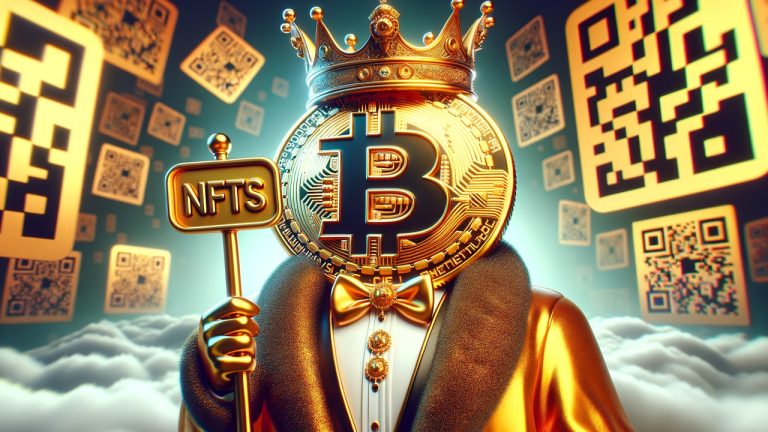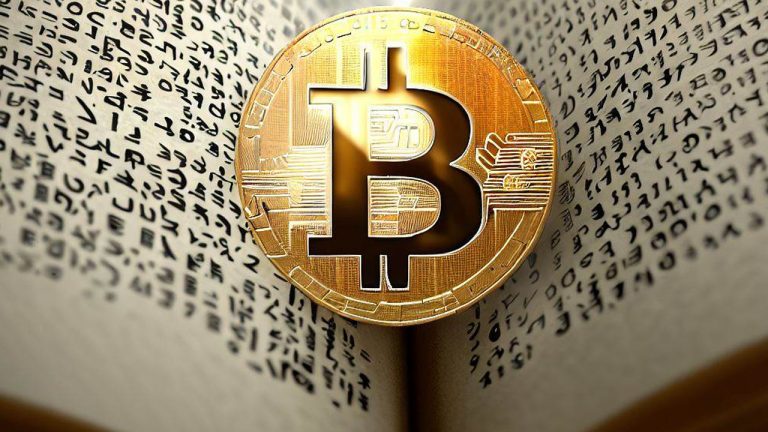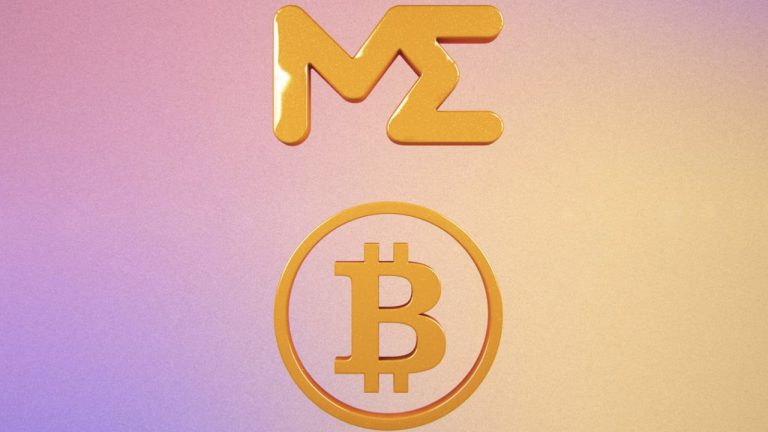 While sales of non-fungible tokens (NFTs) have declined by over 38% in the past 30 days compared to the previous month, NFTs minted on the Bitcoin blockchain have dominated, accounting for more than 44% of sales. Statistics from the last 30 days reveal that four of the top five best-selling NFT collections all stem from […]
While sales of non-fungible tokens (NFTs) have declined by over 38% in the past 30 days compared to the previous month, NFTs minted on the Bitcoin blockchain have dominated, accounting for more than 44% of sales. Statistics from the last 30 days reveal that four of the top five best-selling NFT collections all stem from […] On May 15, 2023, the number of Ordinal inscriptions surpassed the 7 million mark and as of 9:00 a.m. Eastern Time on Tuesday morning, 7,204,882 Ordinal inscriptions have been added to the Bitcoin blockchain. Miners have collected 1,324 bitcoin in fees by confirming inscription transactions which equate to roughly $35.86 million in added onchain fees. […]
On May 15, 2023, the number of Ordinal inscriptions surpassed the 7 million mark and as of 9:00 a.m. Eastern Time on Tuesday morning, 7,204,882 Ordinal inscriptions have been added to the Bitcoin blockchain. Miners have collected 1,324 bitcoin in fees by confirming inscription transactions which equate to roughly $35.86 million in added onchain fees. […] On Monday, the non-fungible token (NFT) marketplace Magic Eden announced the launch of Bitcoin Ordinal inscription support. Magic Eden said it has partnered with the wallets Hiro and Xverse to “bring a familiar wallet transaction experience to the marketplace.” Magic Eden’s Decision to Launch on Bitcoin Without Royalty Support and Compete With Emerging Markets Magic […]
On Monday, the non-fungible token (NFT) marketplace Magic Eden announced the launch of Bitcoin Ordinal inscription support. Magic Eden said it has partnered with the wallets Hiro and Xverse to “bring a familiar wallet transaction experience to the marketplace.” Magic Eden’s Decision to Launch on Bitcoin Without Royalty Support and Compete With Emerging Markets Magic […]
Yuga Labs' first Bitcoin NFT collection saw some backlash from the crypto community over the weekend, pointing to flaws in the way it's conducting the auction.
Nonfungible token (NFT) conglomerate Yuga Labs is facing some criticism from the cryptocurrency community, including the creator of Bitcoin Ordinals, over how it plans to auction its new Bitcoin NFT collection.
On Mar. 5, Yuga opened bids for its “TwelveFold” collection which will see 300 NFT-like images inscribed on Satoshis using the Bitcoin-native Ordinals protocol, with 288 from the collection sent to the highest 288 bidders.
The auction for TwelveFold has begun and will conclude on the block immediately prior to 3pm PT tomorrow, March 6th, 2023. Good luck.https://t.co/gvl8IHpekC pic.twitter.com/xGWU9jdCoO
— Yuga Labs (@yugalabs) March 5, 2023
According to a Mar. 5 press release, those participating in the bidding process will be required to send their entire bid amount in BTC to a unique BTC address controlled by Yuga. Winners would simply pay up the BTC they bid, while Yuga said it would return the BTC to those unsuccessful in placing a top bid.
Such a plan however has earned the ire of some within the crypto community, with some pointing out that having to manually conduct refunds for unsuccessful bids is like the “stone age.”
so the way yugas auction will work tomorrow is everyone sends Bitcoin to one wallet and if you lose the bid they promise to manually send it back
— Giancarlo (@GiancarloChaux) March 5, 2023
likely tens of millions of dollars
we’re still in the stone age
The user behind an Ordinals-focused Twitter account “ordinally” called the auction model a “scammers dream” and added while they doubt Yuga would keep the BTC from failed bids, the way it carried out the auction sets a “REALLY bad precedence.”
Yuga is establishing REALLY bad precedence running an auction like this. They are taking custody of bidders’ bitcoin with a promise to send back unsuccessful bids. Not doubting they’ll do that, but this model is a scammer’s dream, and credible players need to set better example.
— ordinally (@veryordinally) March 6, 2023
The post even saw a response from Bitcoin Ordinals creator himself Casey Rodarmor, who hotly weighed in on the discussion telling Yuga to “get fucked” and called the conduct of the auction “degenerate bullshit.”
He added if Yuga were to conduct a similar auction he would encourage others to boycott the project.
Dear @yugalabs,@veryordinally is right. Actions like this prove that for some entities and people: “Once a shitcoiner always a shitcoiner.”
— Casey Rodarmor (@rodarmor) March 6, 2023
If I, personally, Casey Rodarmor, ever see you, Yuga labs, the entity, fuck around with degenerate bullshit like this again, I will wash… https://t.co/COARsn4X0o
Other users pointed out the shortcomings of the auction system, saying it's possible some could overpay for a TwelveFold due to a possible significant price discrepancy between the highest and lowest bids in the top 288.
yuga is going to make a lot of money with twelvefold haha pic.twitter.com/UF7efYmN0k
— frankdegods.eth (@frankdegods) March 5, 2023
Despite the criticism from some, many were happy to see a large project such as Yuga — who rose to prominence due to multiple Ethereum-based NFT collections — bridge across to Bitcoin.
Related: Luxor Mining acquires OrdinalHub amid Bitcoin-based NFTs hype
Ordinally, who earlier criticized the collection, later tweeted appreciation of “the fact Yuga took the effort to attempt [to] go a Bitcoin route when setting up this auction.”
To give credit where credit is due - I really appreciate the fact Yuga took the effort to attempt and go a Bitcoin route when setting up this auction. Somewhat irrationally it pains me even more to see a bitcoin approach setting bad precedent, than an ETH based approach …
— ordinally (@veryordinally) March 6, 2023
An Ordinals-based collection, Ordinal Pizza OG, expressed excitement at Yuga’s BTC collection and called it a “massive net positive for Ordinals.”
The criticisms weren’t enough to stop cashed-up bidders from wanting to try to cement a top spot to nab Yuga’s first BTC collection.
At the time of writing the top bid was 1.11 BTC (around $25,000) according to the TwelveFold website with the lowest bid registered showing as 0.011 BTC, or around $250.

The creator of a Bitcoin Ordinals protocol fork that works on Litecoin said he did it all for a crypto bounty of a few thousand dollars.
A small monetary bounty and an aptitude for coding were all it took to fork the Ordinals protocol to the world’s second-ever cryptocurrency network, Litecoin (LTC) earlier this week, its creator told Cointelegraph.
On Feb. 18, an Australian software engineer by the name of Anthony Guerrera posted a repository to GitHub that forked the Bitcoin (BTC) Ordinals protocol to Litecoin. This allowed for nonfungible token (NFT)-like assets on the Litecoin network in much the same way it had made it to Bitcoin earlier in the year.
In an interview with Cointelegraph, Guerrera said he was spurred to make a Litecoin Ordinal fork due to a 5 LTC bounty posted by the pseudonymous Twitter user Indigo Nakamoto on Feb. 11 that rose to 22 LTC, or about $2,000, to anyone who was first to successfully create a fork.
22 $LTC to port Ordinals to #Litecoin from:
— Indigo | Nakamotoist (@indigo_nakamoto) February 16, 2023
+ 5 $LTC @indigo_nakamoto
+ 5 $LTC @ryanwrights
+ 5 $LTC @MASTERBTCLTC
+ 2 $LTC @ChiefLitecoin
+ 5 $LTC @finitemaz https://t.co/7X4JfMzq97
“I knew it was possible because Litecoin has taproot as well as SegWit,” Guerrera said, adding:
“I was in a bit of a mad rush to try and get it done as fast as I could.”
Taproot and SegWit are the names given to the Bitcoin protocol updates that aimed to improve the privacy and efficiency of the network but also allowed for NFT-like structures called “inscriptions” to be attached to satoshis.
The cost to inscribe an image onto the Bitcoin blockchain can cost tens of dollars depending on its size but Guerrera said the cost to inscribe a litoshi — the LTC equivalent to a satoshi — is “about two cents.”
A point of contention amongst Bitcoiners is the block space Ordinals take up on the network due to their data size being far greater than transactions. Guerrera doesn’t think this issue will be as prominent on Litecoin due to its larger block size but could still possibly eventuate.
“Pandora's Box has already been opened and someone was going to do it so it may as well be me.”
Guerrera said his LTC fork took around one week to create as “the changes were quite simple.” He explained he updated the Ordinals code to work with inputs from the Litecoin network instead of the Bitcoin network.
Parameters that differed between the blockchains such as the total possible number of coins and block time creation differences also had to be accounted for in the fork.
In a Feb. 19 tweet, Guerrera said he’d inscribed the first ever Litecoin Ordinal, putting the MimbleWimble whitepaper onto the blockchain in the so-named “inscription 0.”
The first #Litecoin #Ordinal has been inscribed on the Litecoin blockchain.
— Crypto Anthony (@anthonyonchain) February 19, 2023
The mimblewimble whitepaper will live within Litecoin forever Ⓜ️ #MWEB!$LTC $BTC #NFT @SatoshiLite @finitemaz @ryanwrights @MASTERBTCLTC @ChiefLitecoin @indigo_nakamoto pic.twitter.com/ICLkTMjwRW
The inscription of the whitepaper is in the wake of the May 2022 Mimblewimble Extension Blocks (MWEB) upgrade that allows Litecoin users to opt-in to confidential transactions and other blockchain improvements such as helping reduce excess and unnecessary transaction data.
Related: How the Ordinals movement will benefit the Bitcoin blockchain
“I wanted to dedicate the first inscription to that and make it aware that Litecoin now has this privacy sidechain attached to it,” Guerrera said.
“I'm a fan of the technology and I like that privacy can become a thing on these public ledgers.”
As for the future of the forked protocol, Guerrera will “keep contributing to this fork as much as I can” and port across updates from the original Ordinals.
“I probably want to hand over this as I don't want it to take too much of my time,” he added. “I'm doing other things. I've got other things on my plate.”
 Statistics show transfer fees on the Bitcoin network have increased 122% since the end of last month, as the average transaction fee has climbed from $0.767 to $1.704 per transaction. The rise in onchain fees coincides with the new Ordinals digital collectible trend on the network, with the number of inscriptions nearing 20,000. Rising Transaction […]
Statistics show transfer fees on the Bitcoin network have increased 122% since the end of last month, as the average transaction fee has climbed from $0.767 to $1.704 per transaction. The rise in onchain fees coincides with the new Ordinals digital collectible trend on the network, with the number of inscriptions nearing 20,000. Rising Transaction […]
A rather unsavory image made it to the front page of the Ordinals website for 30 minutes before it was hidden, however, the image itself is immutable.
Only days after the launch of the Bitcoin (BTC)-based Ordinals protocol, its creator had to deal with their first shock pornographic image, which has been inscribed into the blockchain.
On Feb. 2 at around 12:15 am UTC, an unsavory image known as “goatse” was inscribed onto the Bitcoin blockchain via the Ordinals protocol.
It featured on inscription 668 and was live on the Ordinals’ front page for roughly half an hour before the image was removed. It still exists on the blockchain but is not able to be viewed using the Ordinals website.
Ordinals creator Casey Rodarmor told Cointelegraph he acted quickly to remove the image from the Ordinals website but admitted there isn’t much that can be done to stop future instances given the nature of the protocol.
He is at least working on a solution to stop the images appearing on the Ordinals website.
The image, known as “goatse,” depicts a man manipulating his anus. Due to its shock value, it’s often used to trick internet users.
Rodamor said for the moment, that there was no way to hide certain inscriptions on the Ordinals’ website without manual input.
“The explorer has a config file that can be used to hide certain inscriptions, so we decided that was not very pleasant to look at,” he said. “We added it to that config file and now the server does not return that inscription and will not return that content.”
Ordinals has a simplistic website with every new inscription appearing on its home page.
While Rodarmor plans to have a “very liberal content policy” where people will “certainly” be able to inscribe pornographic images, he would like to censor them until he finds a way to automatically keep them off the first page, such as creating a separate space for them on the website.

Critics of blockchain technology have concerns that its immutable nature could be used to forever host illegal or grotesque media, while others argue its censorship resistance should be viewed as a key feature.
Asked if he was concerned about the criticism Ordinals may receive for censoring certain images, Rodarmor responded:
“The inscription is still on the chain and if you run your own copy of Ordinal — which everybody is free to do — it will not have that config file and you will see the gaping butthole if that is what you so desire.”
He added his site is just one instance of the block explorer and hopes others create more where they can “implement their own moderation policies according to their tastes.”
Related: ‘WTH did I just witness?' Magic Eden turns porno after hosting service hacked
Rodarmor said it’s only the second time he’s censored a pornographic image. He believes the technical difficulty and cost of inscribing an image onto the BTC network have reduced the instances of such trolling attempts.
Ordinals launched on Jan. 21 and immediately divided the crypto community with arguments on whether it was good for the Bitcoin ecosystem.
The protocol works by inscribing satoshis — the native currency of the Bitcoin network — with content such as images to make NFT-like structures that can be transferred.
The cost of inscribing a satoshi can cost tens of dollars in comparison to a regular network transaction that ranges from a few cents to a few dollars.